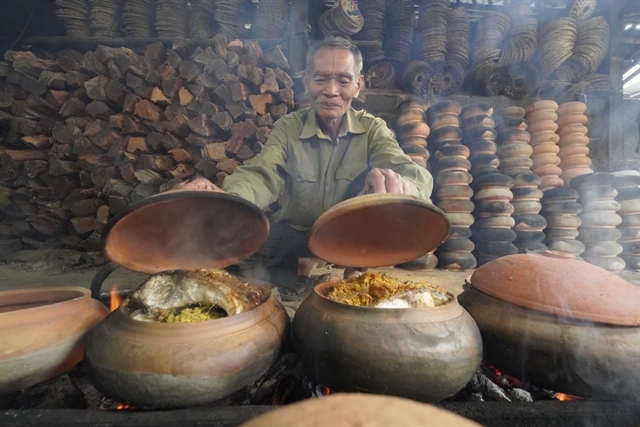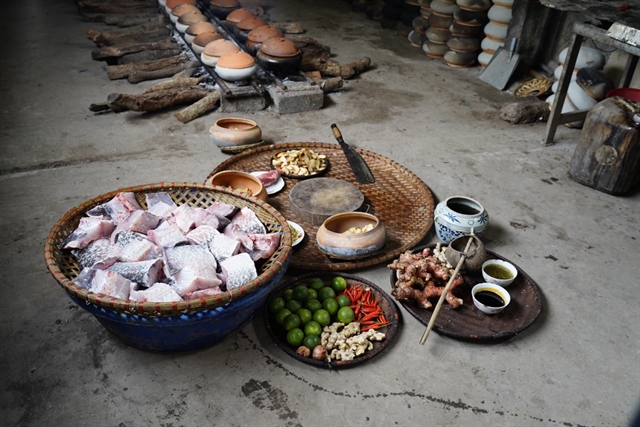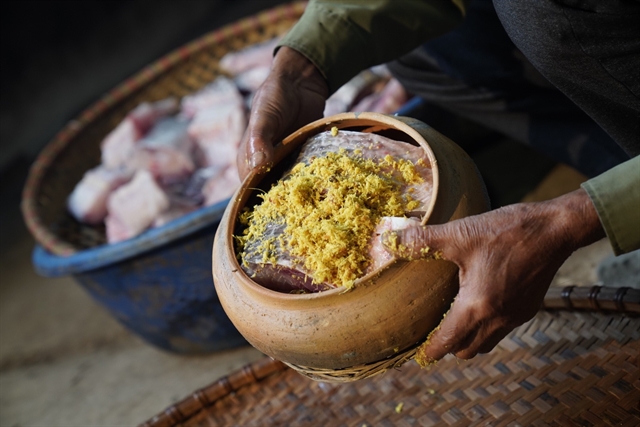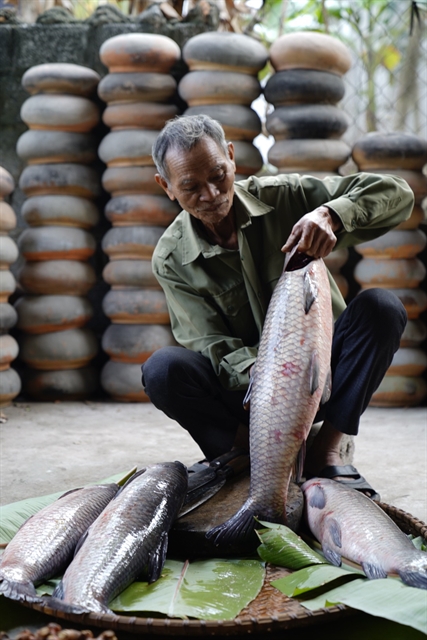 Life & Style
Life & Style


|
| HEATING UP: Trần Duy Thế covers the Bát Tràng pots with special lids ordered from Thanh Hóa Province. |
by Nguyễn Mỹ Hà
When writer Nam Cao wrote Chí Phèo in 1941, he not only created one of Việt Nam's literary masterpieces of the 20th century, but the fictional name he gave to his home village also became known across the country. Nam Cao's home village of Đại Hoàng has become Vũ Đại, a village of desperate human fates, who were forced into destitution and poverty.
The stories were written before the August Revolution, which gave birth to today's Socialist Republic of Việt Nam. Later in 1982, based on several of his short stories, a black and white film was made titled, Làng Vũ Đại Ngày Ấy, (Vũ Đại village in those days).

|
| VITAL PARTS: Ten ingredients to make the village's signature fish stew. |
But the name of Vũ Đại once again made headlines across the country, not for its poverty or austerity, but for one of its delicacies – the fish stew.
Among the items for Vietnamese people's Tết food tray, the fish stew used to be a must-have. It seems that today, each village claims their delicacy is the best, but the fish stew often uses big fish living in the pond, and only caught at the end of the year, when they clean the pond and change the water.
The black carp, which often live in the lower bed of ponds, lakes or rivers, can weigh up to more than 10kg and measure 1.8m long. The best fish for the stew weigh from 4 or 5 to 7 kilos. They used to be caught in the wild, but due to recent high demand for Tết, the black carp are grown in fish farms and fed with snails and corn, thus are named snail carp.
Outside of Việt Nam, these fish are also found in the Amur river, and called black amur, or in China where it's known as black Chinese roach. Hà Nội's biggest freshwater lake, Hồ Tây, or West Lake, is also home to black carp.

|
| BIG AND SMALL: The fish pots come in different sizes, but flavours stay the same. |
We made it to Đại Hoàng village to look at how these terracotta fish stew pots were made. Trần Duy Thế, 73, the masterchef of the fish stew, was demonstrating how he cleaned the fish, marinated the pieces and then heated the pot on wood furnaces for up to 14 hours.
He shows a fish of a little above 5kg, gutted it and cleaned it with fresh lemon juice, then again with rock salt. Then he marinated the fish with pounded ginger, galangal, dried shallot, chili, fish sauce, field crab sauce, lemon juice, pork belly meat and pepper.
Trần Duy Thế used to cook this fish stew for his fellow soldiers during his two times serving in the army. He joined the military first in 1972, then demobbed in 1975 when Việt Nam was reunified. In 1979, he picked up arms again to fight the border war until he retired in 1988. His fellow soldiers used to visit him in the village and he would cook for them. The dish was simple, little did he know then that it would be a source of additional income in his later years.

|
| SPICE IS NICE: Pounded hot spices including ginger, galangal and chili. VNS Photos Bùi Diệu Minh |
"My father shares his recipe with our sister," says Trần Duy Ninh, his youngest son, an army officer-turned-CEO of the family company. This is quite shocking, as in many craft families, the secrets are taught only to the daughter-in-law, not to their daughters, as they would marry out and spread the recipe out of the family circle.
"We believe that the further we share it, the more people would want to try our products," his son said. "And in cooking, even if you have the recipe, each person shall make a different dish, they shall not taste the same."
What he said is definitely true, because today, families living in the city can never have a wood furnace to cook a fish pot for over 10 hours. And even in Đại Hoàng village, each family's fish pot has a difference, you'll need to try them to tell.

|
| MASTER CHEF: Cleaning and cutting the fish needs strong hands, and a good technique. |
In the rush for Tết, Ninh said his family would employ a couple of people to help with the processing, but the major chef shall be his father with his sister as sous chef.
"We need to keep our father in good shape, not to make him work too hard. In the end, it is still a home delicacy, cooked with love and care. So we want our father to be well and in good shape for Tết."
If you want to visit the village today, you can still ask for Vũ Đại Village, because it no longer stands for destitute, today's Vũ Đại means great fish pot stews. VNS




